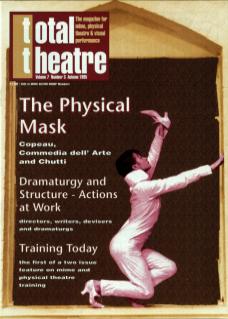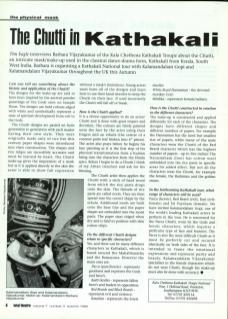Can you tell me something about the history and application of the Chutti?
The designs for the make-up are said to have been inspired by the ancient powder paintings of the Gods seen on temple floors. The designs use bold colours edged with white and symbolically represent a state of spiritual development from evil to the Gods.
The Chutti designs are passed on from generation to generation with each master having their own style. They were originally made only of rice but this Century paper shapes were introduced into their construction. The shapes and rice ridges are incredibly accurate and must be learned by heart. The Chutti make-up gives the impression of a mask but as it is applied directly to the skin the actor is able to show full expression without a mask's limitations. Young actors must learn all of the designs and learn how to use their facial muscles to keep the Chutti on their face. If used incorrectly the Chutti will fall off or break.
How is the Chutti applied?
It is a divine opportunity to do an actor’s Chutti and it is done with great respect and devotion. The colours are firstly painted onto the face by the actor using their fingers and an erkula (the centre of a coconut palm leaf broken into six-inch pieces). The actor also prays before he begins his face painting as it is the first step of his physical transformation from a human being into the characters from the Hindu epics. Before I begin to do a Chutti I think of my Ashan (teacher) and ask for his blessing.
The Chutti artist then applies the Chutti with a stick of hard wood from which the rice paste drops onto the skin. The threads of rice paste are called nools. They are then spread into the correct shape by the erkula. Additional nools are built onto the base line and the paper shapes are embedded into the moist paste. The paper stays ridged when dry and is held in position with thin cotton strips.
Do the different Chutti designs relate to specific characters?
Yes, and there can be many different characters in Kathakali, which is based around the Mahabharatha and the Ramayana. However the main ones are:
Pacca (pure/heroic) – represents goodness and expresses the Gods and heroes.
Katti (knife) – represents fallen heroes and leaders in opposition.
Red Beards and Black Beards – represents evil and violence.
Katarlan – represents the forest dweller.
White Beard Hannuman – the devoted monkey God.
Minikku – represents female/radiant.
How is the Chutti constructed in relation to the different characters?
The make-up is constructed and applied differently for each of the characters. The designs have different shapes and different numbers of papers. For example the Hannuman has the most but smallest size of papers, while many of the male characters wear the Chutti of the Red Beard character which has the highest number of papers – up to five inches! The Narasimham (lion) has cotton wool embedded into the rice paste in specific areas for added effect. But not all the characters wear the Chutti; for example the female, the Brahmins and the golden swans.
In the forthcoming Kathakali tour, what range of characters will be used?
Pacca (heroic), Red Beard (evil), Kari (evil female) and Sri Vaysham (female). We have invited Kalamandalam Gopi, one of the world's leading Kathakali actors to perform in the tour. He is renowned for the Pacca Chutti, worn by the Gods and heroic characters, which requires a particular type of face and features. The Pacca is also the most difficult Chutti as it must be perfectly cut and secured identically on both sides of the face. It is intended to frame the emotional expressions and represent purity and beauty. Kalamandalam Vijayakumar specialises in the female characters which do not wear Chutti, though his make-up must also be done with accuracy.

